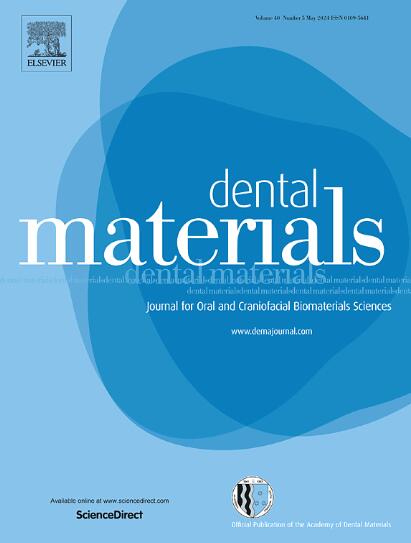接受 3 秒高辐照方案处理的散装红细胞中短期直流电结果的多样性。
IF 4.6
1区 医学
Q1 DENTISTRY, ORAL SURGERY & MEDICINE
引用次数: 0
摘要
目的确定高辐照度光固化(LC)方案对不同松散填充树脂基复合材料(RBC)的透光率(LT%)、辐射照射(RE)和转化率(DC%)的短期(5 分钟)初始影响:研究了六种不同粘度的填充复合材料:OBF (One Bulk Fill, 3 M)、EB (Estelite bulkfill, Tokuyama)、PFill、PFlow、ECeram 和 EFlow (PowerFill, Poweflow, Tetric EvoCeram bulkfill, Tetric Evoflow bulkfill, Ivoclar)。2 W/cm2 -10 s 和 20 s,通过 PowerCure 和 Elipar S10 LCU)。试样(n = 5)在模具(ϕ5 mm × 4 mm 深度)内聚合,使用 MARC-LC 光谱仪测定 4 mm 处的 LT% 和 RE。在使用傅立叶变换红外光谱实时测量 DC% 时,也使用了类似的模具。数据分析采用单因素方差分析和 Tukey 后检验,显著性为 5%:无论采用哪种液相色谱方案,OBF和低粘度RBC(EB、PFlow和EFlow)的LT%、RE、DC%和RPmax分别最低和最高。所有 RBC 的 RE 结果顺序相同:Elipar-20 秒 > PCure-10 秒 > PCure-3 秒。PFill 和 PFlow 的 DC% 在所采用的 LC 方案之间没有显著差异(p > 0.05)。所有材料的聚合动力学都能很好地用指数函数(r2 在 0.85 和 0.98 之间变化)来描述,显示 PCure-3 s 方案的聚合速度更快:意义:通过测量 5 分钟时的 LT% 和 DC%,可以了解聚合过程的发展情况。这些块状填充复合材料对高辐照方案的初始反应因其成分和粘度而异,低粘度材料的反应速度更快。尽管如此,尽管多种树脂复合材料在光聚合过程中的设计效率很高,但在选择材料/固化方案时仍需谨慎。本文章由计算机程序翻译,如有差异,请以英文原文为准。
Diversity of short-term DC outcomes in bulk-fill RBCs subjected to a 3 s high-irradiance protocol
Objectives
To determine the short-term (5 min) initial effects of a high-irradiance light-curing (LC) protocol on light transmission (LT%), radiant exposure (RE) and degree of conversion (DC%) of different bulk-fill resin-based composites (RBCs).
Materials and methods
Six bulk-fill composites with different viscosities were investigated: OBF (One Bulk Fill, 3 M), EB (Estelite bulkfill,Tokuyama), PFill, PFlow, ECeram and EFlow (PowerFill, Poweflow, Tetric EvoCeram bulkfill, Tetric Evoflow bulkfill, Ivoclar), subjected to different LC protocols: one ultra-high-intensity (3 W/cm2 −3 s via PowerCure LCU) and two conventional (1.2 W/cm2 −10 s and 20 s via PowerCure and Elipar S10 LCUs). Specimens (n = 5) were polymerized within their molds (ϕ5 mm 4 mm depth) to determine LT% and RE at 4 mm using a MARC-LC spectrometer. For real-time DC% measurements by FTIR, similar molds were utilized. Data were analyzed by one-way ANOVA and Tukey post-hoc tests at 5 % significance.
Results
Regardless of the applied LC protocols, OBF and low-viscosity RBCs (EB, PFlow and EFlow) had the lowest and highest LT%, RE, DC% and RPmax, respectively. RE results of all RBCs were in the same sequence: Elipar-20 s > PCure-10 s > PCure-3 s. DC% of PFill and PFlow displayed no significant difference between the applied LC protocols (p > 0.05). The polymerization kinetic in all materials was well described by an exponential sum function (r2 varied between 0.85 and 0.98), showing a faster polymerization with the PCure-3 s protocol.
Significance
The measurement of LT% and DC% at 5 min gave an insight into the developing polymerization process. The initial response of these bulk-fill composite to a high-irradiation protocol varied depending on their composition and viscosity, being faster for low viscosity materials. Nevertheless, even though multiple resin composites are designed to be efficient during photopolymerization, care should be taken when selecting materials/curing protocol.
求助全文
通过发布文献求助,成功后即可免费获取论文全文。
去求助
来源期刊

Dental Materials
工程技术-材料科学:生物材料
CiteScore
9.80
自引率
10.00%
发文量
290
审稿时长
67 days
期刊介绍:
Dental Materials publishes original research, review articles, and short communications.
Academy of Dental Materials members click here to register for free access to Dental Materials online.
The principal aim of Dental Materials is to promote rapid communication of scientific information between academia, industry, and the dental practitioner. Original Manuscripts on clinical and laboratory research of basic and applied character which focus on the properties or performance of dental materials or the reaction of host tissues to materials are given priority publication. Other acceptable topics include application technology in clinical dentistry and dental laboratory technology.
Comprehensive reviews and editorial commentaries on pertinent subjects will be considered.
 求助内容:
求助内容: 应助结果提醒方式:
应助结果提醒方式:


